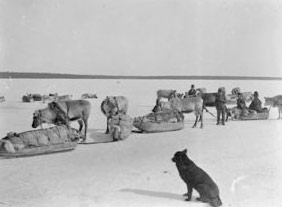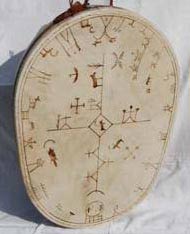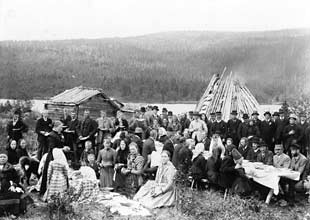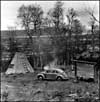The Sami
Sápmi, the land of the Sami, encompasses four countries: the northern parts of Sweden, Norway, Finland and the Kola peninsula in Russia. Having originally been hunters and fishermen, some Sami people started leading a nomadic lifestyle herding reindeer during the 14th to 16th century.

Reindeer raid on Lake Malgomaj. © Västerbottens museum
During the 17th century, the colonisation of northern Sweden began. As more and more settlers settled down, the possibilities of reindeer herding became limited. Many of the Sami became settlers themselves and moved into the villages and communities that were forming.
Today, the reindeer are often herded with the aid of snow-mobiles and helicopters and most of the Sami now have permanent homes.
Sami faith
The pre-Christian Sami believed in the spirits of nature and in a plethora of gods. These gods could reside inside a mountain, in a lake or by a stream. The seite – a symbol of a sami deity – was often constituted by a strangely shaped rock or wooden log. At the seite sacrifices were made to the gods to ensure the wellbeing of the family and of the reindeer herd. It was also a place where people could ask for help or show gratitude. There are several well-known sacrificial sites in the mountain areas around Vilhelmina.
In the collections

© Max Lundström
In the museum's collections there are, amongst other things, Sami hymn books, sleighs (ackjor), harnesses and a Sami cradle. On the top floor of the museum there is a replica of a seite from Marsfjällen.
In a display case at the entrance of the museum there are also two Sami drums, admittedly fabricated in modern time but with the old symbols. The drums are made by Max Lundström och Sven-Åke Risfjell, two of Vilhelmina’s talented craftsmen.
Some of the Sami remnants in the municipality of Vilhelmina:
- Bäsksjö
- The most southern Sami sacrificial ground was discovered around 1930 in Bäskjö where three silver coins from early medieval times (one from Denmark, one from Germany and one from Sweden), a tin cross, glass beads and a reindeer horn were discovered
- Spaunakullen
- At Spaunakullen in Bielite there are ancient remains from old Sami huts and reindeer pastures. The Sami have lived here for many generations. Dated coal from fireplaces shows that this site was used as early as a 1000 years ago.
- Gråtanån
- At Gråtanån there is a bear grave from the 15th to 17th century. The bear was a holy animal and more highly regarded than any other animal. If the bear hunt had been successful, the bear was brought home accompanied by singing and a big celebration was held. The bones were later collected and buried in hopes that the bear would reincarnate and be possible to kill again. At the grave in Gråtanån, four unfired lead bullets were found placed next to the bear’s cranium.
- Tomasvallen
- Tomasvallen got its name from it's last resident, Tomas Fjällström (Big Tomas). Here you find remnants of old Sami huts and also traces of early 18th century agriculture.
- Vielmesmakke
- Vielmesmakke is an old Sami habitat that was used by Sami from Borgafjäll and Storjola during the summer and fall. There was also a Sami school held in one of the huts during 1926 - 1950. Today Vielmesmakke is mostly unhabitated and most huts and buildings are owned privately.
- Fatmomakke
- Fatmomakke has been the natural rendez-vous spot for Sami ever since the 16th century. In time, the settlers aslo started coming here. To be able to spend church weekends here, the Sami built huts along the slopes around lake Kultsjön while the settlers built their timber chalets closer to the water. The first chapel was built in 1790 and the current church was built in the 1880's. Church weekends are still celebrated in Fatmomakke church town.
 Wedding in Fatmomakke church town, 1890
© Vbm
Wedding in Fatmomakke church town, 1890
© Vbm
Further reading
- Sápmi - the Sami Information Centre
The Sami Information Centre is a national source of knowledge about the Sami people and Sami culture. They are also a part of the Sami Parliament.
- Short Sami facts

- Did you know that...
- ...Vilhelmina is part of the south Sami area in Sapmi?
- ...Västerbotten is divided into 7 sami villages, of which two are situated in Vilhelmina?
- ...about 500 people speak south Sami and that the Sami language became an official minority language in Sweden on April 1, 2000?